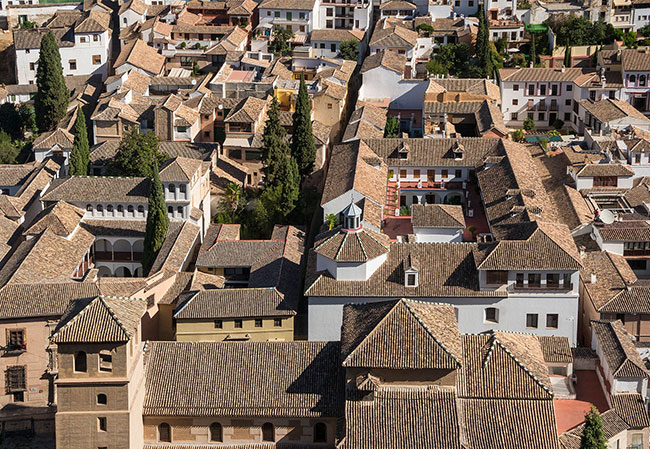GRANADA FELL, BRINGING ALL OF SPAIN UNDER CHRISTIAN RULE

[ABOVE: Tiled roofs of patrician houses in the lower part of the Albayzin neighborhood, Granada, Spain. Jebulon / public domain, Wikimedia File:Roofs Albayzin Granada Spain.jpg I, the copyright holder of this work, hereby publish it under the following license: This file is made available under the Creative Commons CC0 1.0 Universal Public Domain Dedication]
The Islamic Moors conquered most of Spain in the eighth century. However, in the north of Spain, Christians held a small area of mountain fastnesses where they defeated the Moors. Gradually they expanded this territory. Three kingdoms emerged as the Christians recovered lost lands: Navarre, Castile, and Aragon. In 1469 the heirs of Aragon and Castile, Ferdinand and Isabella, united in marriage. Ten years later, after they ascended their respective thrones, they acted as one.
Moors in the south had been reduced to paying annual tribute. However, in 1478, Abul Hassan, the new king of Granada, refused to pay the tribute. Pressed for it by Spanish ambassadors, he replied that in the same place where coins were minted in Granada swords were also forged to prevent those coins from being taken. Ferdinand and Isabella prepared for war.
Abul Hassan struck first with a surprise attack on the fortress town of Zahara in 1481, the night after Christmas. The Spanish immediately fortified all their remaining border towns. Many Moors became afraid, realizing they had wakened a sleeping giant in the newly united Christian kingdoms. One old counselor was said to have exclaimed, “Woe is me! The ruins of Zahara will fall on our heads. The days of the Moslem empire in Spain are numbered!”
Retaliation was not long in coming. The city of Alhama sat about twenty-four miles north of Granada and was a key to Granada’s protection. A natural fortress, it was considered impregnable. Don Rodrigo Ponce de Leon, Marquis of Cadiz, received information that led him to believe he could seize the city if he could reach it unseen. He knew a victory at Alhama would grant him favor at court to redeem former opposition to the king and queen. In February 1482, under cover of bad weather, he set out. His attack was successful. However, a siege by Abul Hassan almost overwhelmed him in March. The Marquis’ sworn enemy, the Duke of Medina Sidonia, came to his rescue and the two became fast friends. Ponce de Leon would be one of the most notable generals in the coming war, delivering blows in desperate and dangerous moments.
Ferdinand and Isabella were quick to seize the opportunity the Marquis of Cadiz had opened to them. Ferdinand took the field immediately. The war lasted a decade and each year saw the Spanish whittle away at the fortresses, towns, and cities around Granada. Early efforts were repulsed at Loja and Malaga; but by destroying enemy crops and demolishing enemy fortresses with heavy artillery, the Christians advanced, capturing the Moorish kingdom’s main port, Malaga, and the key city of Baza.
Outraged at Abul Hassan for bringing war upon them, the people of Granada deposed him for his son Boabdil. Boabdil proved to be an ineffectual leader; Hassan’s brother El Zagal seized the throne. Civil war raged in Granada. Boabdil himself was captured by the Spanish and swore fealty to them. However, he later rebelled, because soldiers and refugees in Granada refused to surrender without a fight.
By 1491 the city of Granada fought alone. After fire destroyed the Spanish camp, Ferdinand ordered a permanent settlement built for his troops six miles from the Moorish capital. Santa Fe was completed in three months. Realizing resistance was futile, Boabdil secretly negotiated a capitulation to take place late in January. Although starving, the people of Granada were furious when they found out, and they rioted. Afraid of prolonging the war, Ferdinand moved the capitulation forward.
Thus it came about that on this day, 2 January 1492, Granada formally surrendered. Christian troops mounted a silver cross on a high building and raised their monarch’s flag. When Boabdil left, he asked that the gate from which he exited be walled up. It was.
The Christians soon violated their agreements and the Moors rose again and again in rebellion from 1500 onward. In 1502 Spain issued an edict for the expulsion of all unbaptized Moors. With the implementation of that edict, an occupation that had lasted eight centuries came to its end.
—Dan Graves





